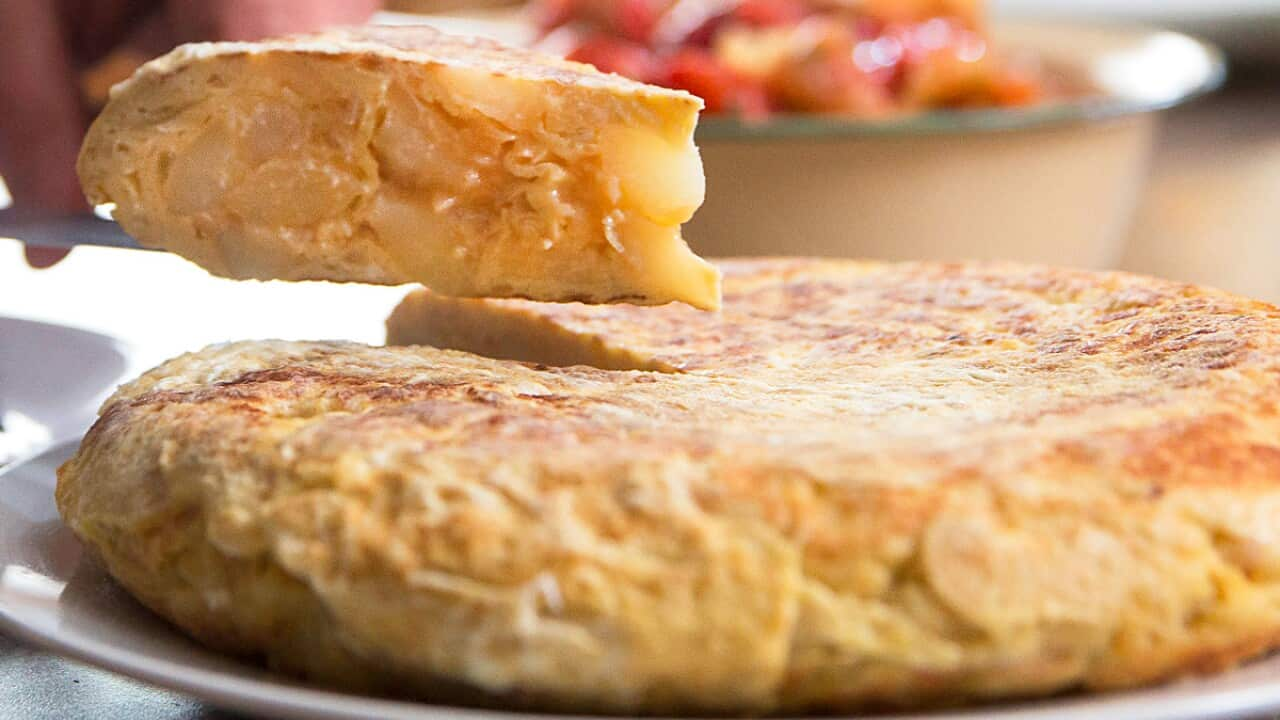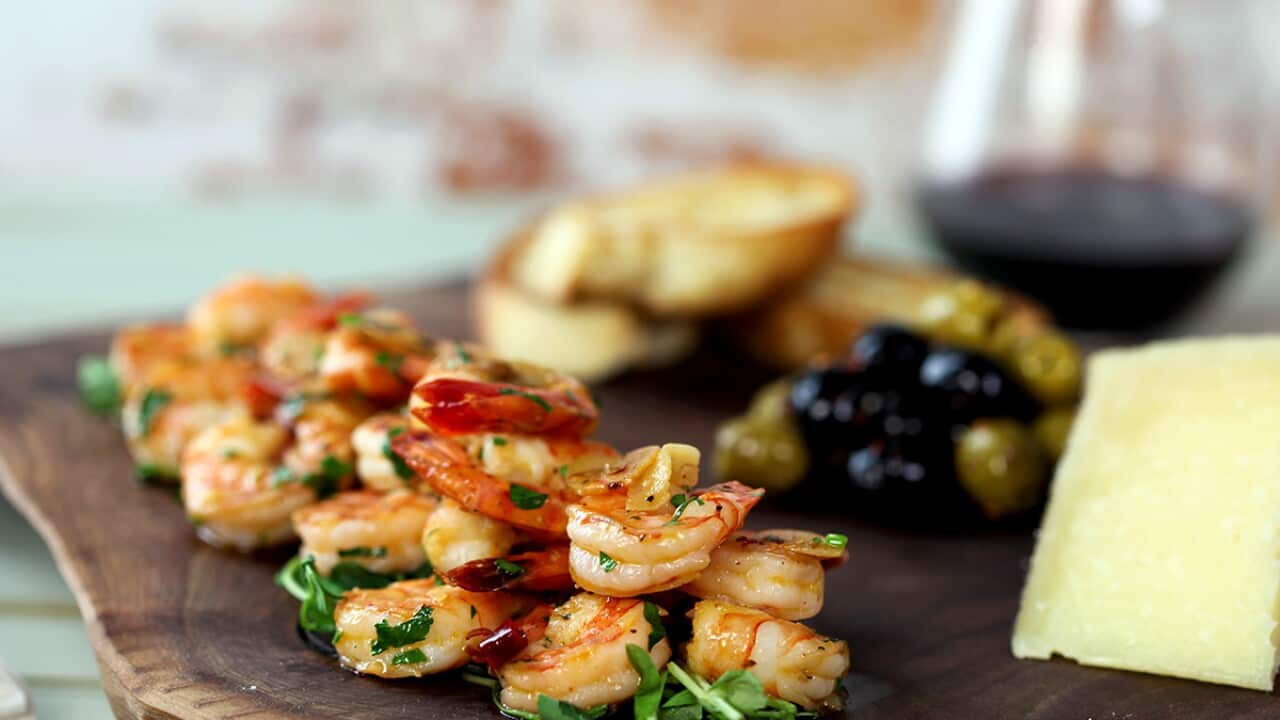Galicians traditionally don't overthink ingredients. Salt. Olive oil. Paprika. A dash of vinegar. Perhaps a little garlic. But what this culinary canon does prize, says Galician-born-and-raised Voyager Estate head chef, Santiago Fernandez, is produce, technique and heritage.
"At home as a child, just one kilometre from home, everything was there," Fernandez tells SBS Food of his Galician upbringing, citing a labour-driven agricultural economy as being largely responsible for an unembellished yet hearty diet.
GALICIAN FOOD

Empanada gallega (galician pie)
Atlantic flavours were the mainstay: bivalves, mussels, cockles, clams and smaller fish — sardines and anchovies. Pork as well. Grass-fed. Lots of tomatoes. Cheeses. Flour and strong breads. Simple flavours and large plates to satiate families who worked on boats and in fields.
But what Fernandez really calls home is his Galician grandmother's octopus dish.
"My paternal grandmother, I remember she was an excellent cook. A really great chef. She had this laugh and was really smart and clever," he smiles, reminiscing over Sunday lunches at her home. "Everything she cooked tasted of the love and the passion she put into it. And the way she cooked that octopus, the flavour stuck in my head."
The way she cooked that octopus, the flavour stuck in my head.
Fernandez's head was where that octopus flavour stayed for many years, even though he looked for a world that was bigger and more complex than the Galician savour of his childhood.
The offer to join his father and take up knives in his family's village asador restaurant wasn't enough. He'd worked there since the age of 13, peeling potatoes and helping in the kitchen. Fernandez wanted something different, something more than meat and a traditional open grill and fire. So he packed up his memories, applied for ships captaincy studies at a polytechnic and was promptly handed his second choice: culinary school.
It didn't begin well: "We learned French cookery and the first two years were pretty much spent chopping, dicing and doing basic sauces. It wasn't interesting to me."
But a few of his teachers saw something in Fernandez and insisted he push himself. By the late '90s, he'd finished his studies just as acclaimed Spanish restaurants el Bulli and Mugaritz arose. Spanish cookery was making the world sit up and take notice. This creativity registered deeply with Fernandez and its wave carried him forward.
"I wanted to see what sauces you could make, what combinations," Fernandez recalls, the excitement of that time in his voice.
"I wanted to go to Japan. I wanted to go to India. I wanted to go to travel to Italy and of course to France. As soon as I had this chance I took off to work and travel and earn money. It was great." By 2010, he'd arrived in Daylesford, Victoria, to take up a chef's position at Sault Restaurant Daylesford for what ended up being for six years. It was here that he contacted his aunt about making his grandmother's octopus.
By 2010, he'd arrived in Daylesford, Victoria, to take up a chef's position at Sault Restaurant Daylesford for what ended up being for six years. It was here that he contacted his aunt about making his grandmother's octopus.

Galician chef Santiago Fernandez learned a lot from the simple cooking methods of his grandmother's Galician octopus. Source: Gavin Crawcour and Sarina Kamini
"Even when I became a chef I could never cook it, could never figure out how it was done," Fernandez smiles at the memory of the frustration. "When I asked my aunty, she said, 'you need to fry it first'. And I said, 'the whole octopus?'. She said, 'yes, you need to fry it whole, sear it, keep the juices inside and then cook it slowly and gently'."
The result is a meaty, umami-laden tender experience of an animal that, according to Fernandez, is too often tortured over a flame or has its richness stripped away by excessive use of vinegar.
It's not lost on Fernandez that the simplicity of technique that he ran from became his fascination.
But even with that call to his aunt, it wasn't until the chef arrived in Western Australia's Margaret River with his family in 2016 that he truly brought that dish to life.
The octopus in Victoria wasn't suited to the Galician technique. "We tried but it was terrible," Fernandez grimaces. "But here in Margaret River, with this octopus from Busselton, it works."
Here in Margaret River, with these octopus from Busselton, it works.
The Galician octopus recipe by his grandmother has taught Fernandez that technique can be dependent on produce.
Although Fernandez's position at Voyager Estate restaurant means he is a dab hand with a fancy sauce, what underpins his skill is the hand of his Galician traditions.
"You try the weird combinations, which is great fun and you learn things that way," Fernandez reflects. "But now I have this connection back to what's the produce, what's local, and what's the purpose of doing things."
Love the story? Follow the author here: Instagram . Photographs by Gavin Crawcour and Sarina Kamini.
Galician octopus
Serves 4
Ingredients
- 200 ml olive oil
- 1 small-sized whole octopus, about 1 kg, head removed.
- 3 garlic cloves, crushed
- 30 g fresh ginger, diced
- Salt flakes
1. Carefully clean the octopus, removing the slime, dirt or membrane from its tentacles. Pat dry.
2. In a large pot, heat the oil on high heat and add the garlic and ginger.
3. When the garlic and ginger acquire a golden-brown colour, place the whole octopus in,
tentacles down. Keep the octopus in the same position at high heat for about five minutes
until the skin acquires an intense red colouration.
4. At this stage, flip the octopus and reduce the heat to a minimum.
5. Cover the pot with two layers of cling film to seal the chamber. Make a small hole in the
clingfilm with a toothpick to release some of the steam. Cook the octopus for 20 minutes. Shake the pot every five minutes to make sure that the octopus does not stick. It is very important to reserve most of the octopus juices inside the pot until the end of the cooking process.
6. Remove from heat and rest the octopus 10 minutes before opening the pot.
7. Pierce the octopus flesh with a toothpick. It is ready when tender, only the skin offering a slight resistance.
8. Remove the octopus from the pot and refrigerate for one hour.
9. For the octopus gravy, strain the cooking juices through a fine sieve into a small saucepan
and whisk until fully emulsified, creating a sauce with an unctuous texture. You can also
use a hand blender for this action.
10. Remove the octopus from the fridge. Cut the octopus, separating each leg or into 80 g portions.
11. Heat a non-stick pan until very hot and sear the octopus with a bit of olive oil.
12. Glaze the octopus with the emulsified sauce made with the reserved cooking juices. Season with sea salt flakes.
Note: Spanish sweet paprika is also commonly used to season, alongside salt.












